Strategic Management Report: Coca-Cola Company's Performance
VerifiedAdded on 2021/04/17
|19
|4257
|120
Report
AI Summary
This strategic management report provides a comprehensive analysis of the Coca-Cola Company within the soft drink industry. It begins with an executive summary and an introduction outlining Coca-Cola's historical background and market position. The report then delves into an analysis of the soft drink industry, examining external environmental factors such as technological advancements, social trends, political influences, and environmental regulations. Strategic implications of these factors are discussed, emphasizing the importance of diversification. A competitive forces analysis using Porter's Five Forces model assesses the industry's competitive landscape. The VRIOS framework is applied to evaluate Coca-Cola's internal resources and capabilities, followed by a discussion of strategic implications and a summary of strategic evaluation. The report concludes with a recommendation for corporate diversification and an appendix containing a strategic action plan template.
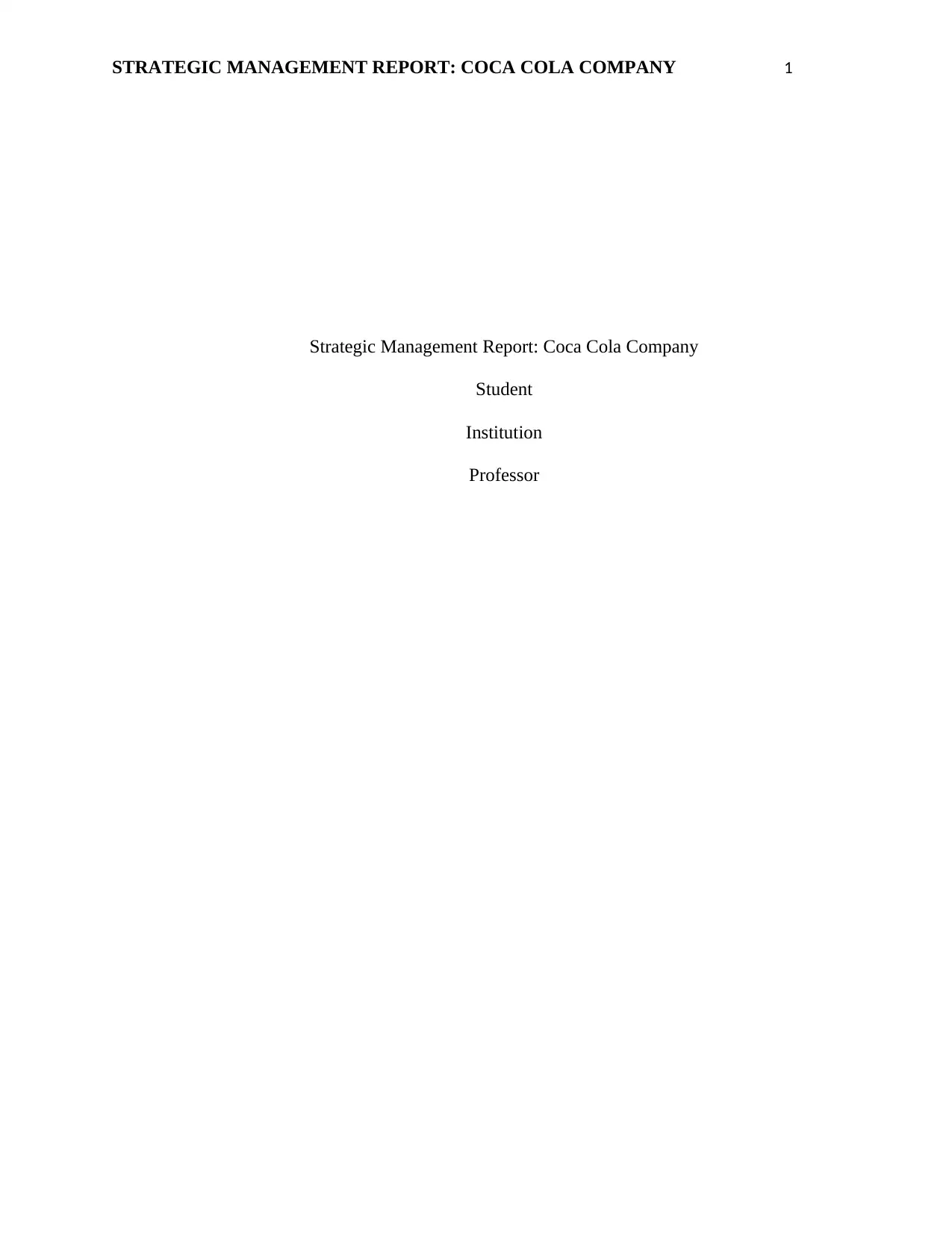
STRATEGIC MANAGEMENT REPORT: COCA COLA COMPANY 1
Strategic Management Report: Coca Cola Company
Student
Institution
Professor
Strategic Management Report: Coca Cola Company
Student
Institution
Professor
Paraphrase This Document
Need a fresh take? Get an instant paraphrase of this document with our AI Paraphraser
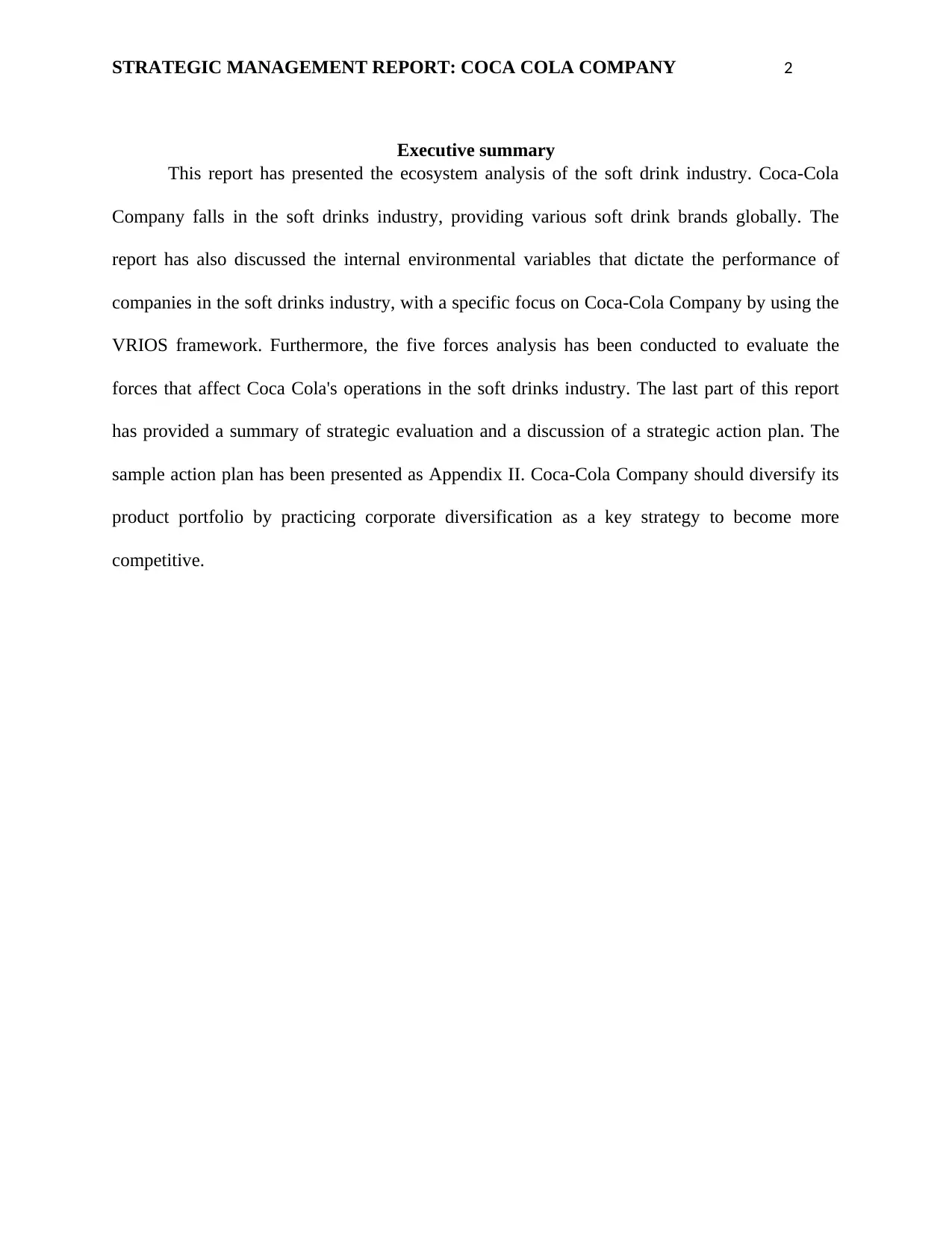
STRATEGIC MANAGEMENT REPORT: COCA COLA COMPANY 2
Executive summary
This report has presented the ecosystem analysis of the soft drink industry. Coca-Cola
Company falls in the soft drinks industry, providing various soft drink brands globally. The
report has also discussed the internal environmental variables that dictate the performance of
companies in the soft drinks industry, with a specific focus on Coca-Cola Company by using the
VRIOS framework. Furthermore, the five forces analysis has been conducted to evaluate the
forces that affect Coca Cola's operations in the soft drinks industry. The last part of this report
has provided a summary of strategic evaluation and a discussion of a strategic action plan. The
sample action plan has been presented as Appendix II. Coca-Cola Company should diversify its
product portfolio by practicing corporate diversification as a key strategy to become more
competitive.
Executive summary
This report has presented the ecosystem analysis of the soft drink industry. Coca-Cola
Company falls in the soft drinks industry, providing various soft drink brands globally. The
report has also discussed the internal environmental variables that dictate the performance of
companies in the soft drinks industry, with a specific focus on Coca-Cola Company by using the
VRIOS framework. Furthermore, the five forces analysis has been conducted to evaluate the
forces that affect Coca Cola's operations in the soft drinks industry. The last part of this report
has provided a summary of strategic evaluation and a discussion of a strategic action plan. The
sample action plan has been presented as Appendix II. Coca-Cola Company should diversify its
product portfolio by practicing corporate diversification as a key strategy to become more
competitive.
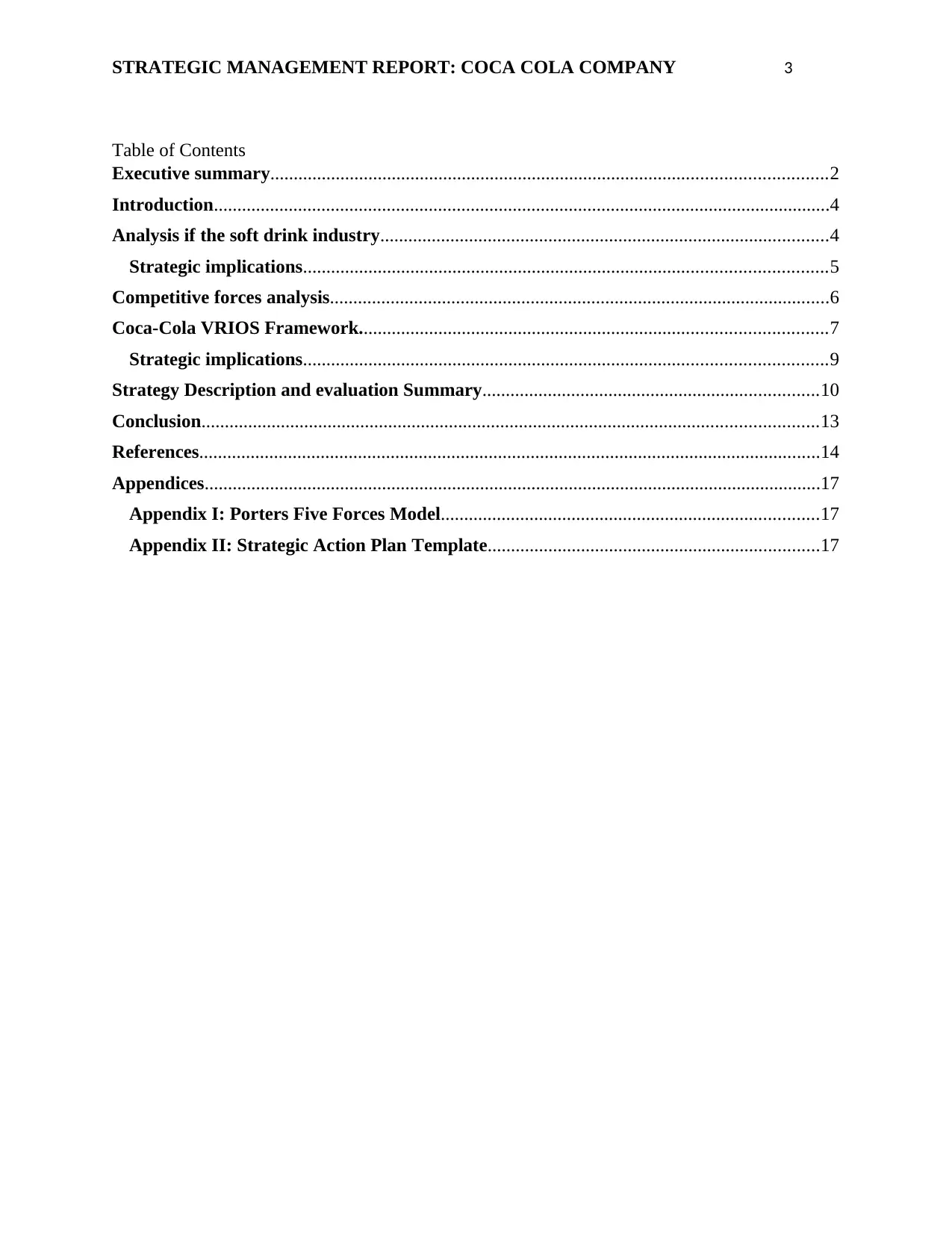
STRATEGIC MANAGEMENT REPORT: COCA COLA COMPANY 3
Table of Contents
Executive summary.......................................................................................................................2
Introduction....................................................................................................................................4
Analysis if the soft drink industry................................................................................................4
Strategic implications................................................................................................................5
Competitive forces analysis...........................................................................................................6
Coca-Cola VRIOS Framework....................................................................................................7
Strategic implications................................................................................................................9
Strategy Description and evaluation Summary........................................................................10
Conclusion....................................................................................................................................13
References.....................................................................................................................................14
Appendices....................................................................................................................................17
Appendix I: Porters Five Forces Model.................................................................................17
Appendix II: Strategic Action Plan Template.......................................................................17
Table of Contents
Executive summary.......................................................................................................................2
Introduction....................................................................................................................................4
Analysis if the soft drink industry................................................................................................4
Strategic implications................................................................................................................5
Competitive forces analysis...........................................................................................................6
Coca-Cola VRIOS Framework....................................................................................................7
Strategic implications................................................................................................................9
Strategy Description and evaluation Summary........................................................................10
Conclusion....................................................................................................................................13
References.....................................................................................................................................14
Appendices....................................................................................................................................17
Appendix I: Porters Five Forces Model.................................................................................17
Appendix II: Strategic Action Plan Template.......................................................................17
⊘ This is a preview!⊘
Do you want full access?
Subscribe today to unlock all pages.

Trusted by 1+ million students worldwide
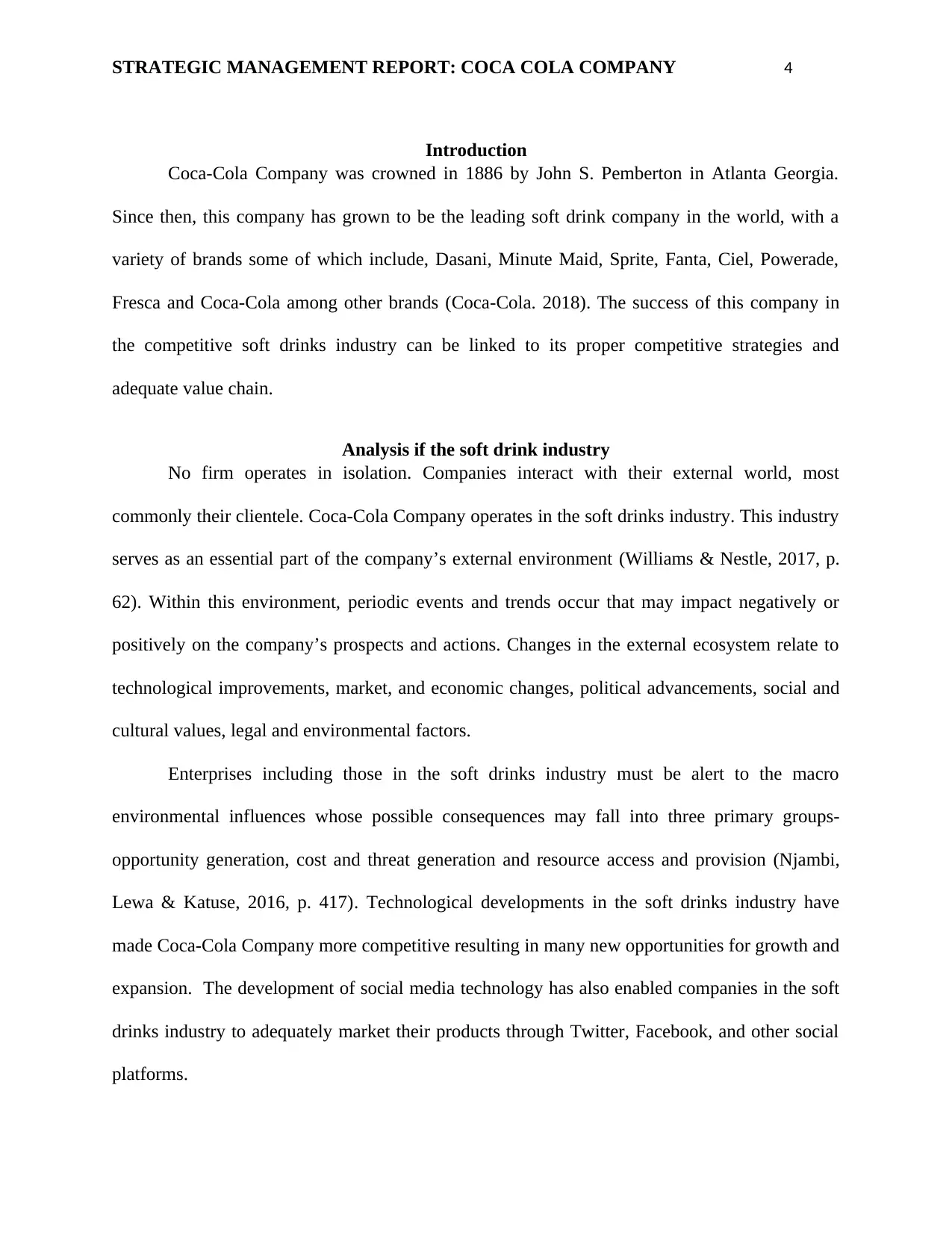
STRATEGIC MANAGEMENT REPORT: COCA COLA COMPANY 4
Introduction
Coca-Cola Company was crowned in 1886 by John S. Pemberton in Atlanta Georgia.
Since then, this company has grown to be the leading soft drink company in the world, with a
variety of brands some of which include, Dasani, Minute Maid, Sprite, Fanta, Ciel, Powerade,
Fresca and Coca-Cola among other brands (Coca-Cola. 2018). The success of this company in
the competitive soft drinks industry can be linked to its proper competitive strategies and
adequate value chain.
Analysis if the soft drink industry
No firm operates in isolation. Companies interact with their external world, most
commonly their clientele. Coca-Cola Company operates in the soft drinks industry. This industry
serves as an essential part of the company’s external environment (Williams & Nestle, 2017, p.
62). Within this environment, periodic events and trends occur that may impact negatively or
positively on the company’s prospects and actions. Changes in the external ecosystem relate to
technological improvements, market, and economic changes, political advancements, social and
cultural values, legal and environmental factors.
Enterprises including those in the soft drinks industry must be alert to the macro
environmental influences whose possible consequences may fall into three primary groups-
opportunity generation, cost and threat generation and resource access and provision (Njambi,
Lewa & Katuse, 2016, p. 417). Technological developments in the soft drinks industry have
made Coca-Cola Company more competitive resulting in many new opportunities for growth and
expansion. The development of social media technology has also enabled companies in the soft
drinks industry to adequately market their products through Twitter, Facebook, and other social
platforms.
Introduction
Coca-Cola Company was crowned in 1886 by John S. Pemberton in Atlanta Georgia.
Since then, this company has grown to be the leading soft drink company in the world, with a
variety of brands some of which include, Dasani, Minute Maid, Sprite, Fanta, Ciel, Powerade,
Fresca and Coca-Cola among other brands (Coca-Cola. 2018). The success of this company in
the competitive soft drinks industry can be linked to its proper competitive strategies and
adequate value chain.
Analysis if the soft drink industry
No firm operates in isolation. Companies interact with their external world, most
commonly their clientele. Coca-Cola Company operates in the soft drinks industry. This industry
serves as an essential part of the company’s external environment (Williams & Nestle, 2017, p.
62). Within this environment, periodic events and trends occur that may impact negatively or
positively on the company’s prospects and actions. Changes in the external ecosystem relate to
technological improvements, market, and economic changes, political advancements, social and
cultural values, legal and environmental factors.
Enterprises including those in the soft drinks industry must be alert to the macro
environmental influences whose possible consequences may fall into three primary groups-
opportunity generation, cost and threat generation and resource access and provision (Njambi,
Lewa & Katuse, 2016, p. 417). Technological developments in the soft drinks industry have
made Coca-Cola Company more competitive resulting in many new opportunities for growth and
expansion. The development of social media technology has also enabled companies in the soft
drinks industry to adequately market their products through Twitter, Facebook, and other social
platforms.
Paraphrase This Document
Need a fresh take? Get an instant paraphrase of this document with our AI Paraphraser
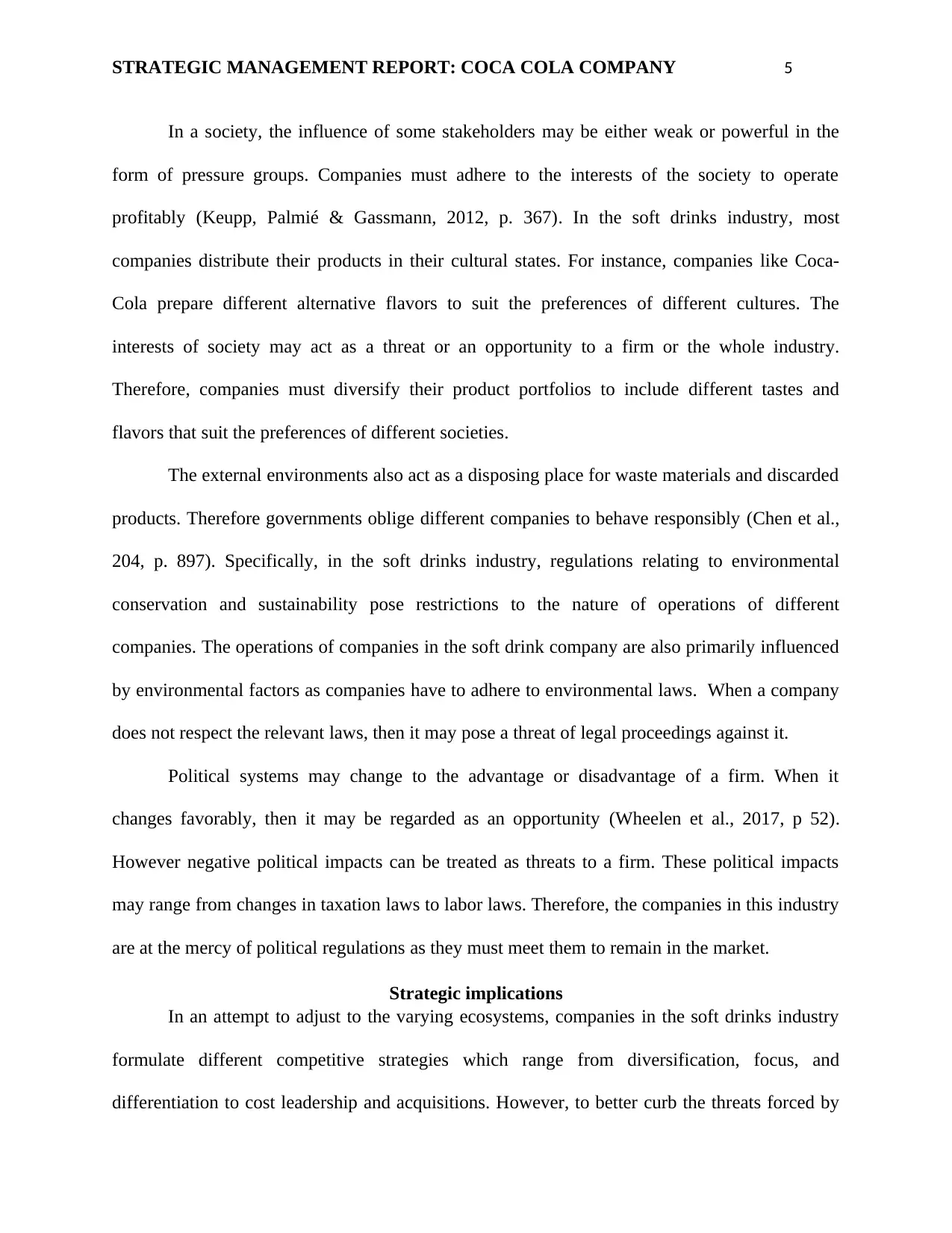
STRATEGIC MANAGEMENT REPORT: COCA COLA COMPANY 5
In a society, the influence of some stakeholders may be either weak or powerful in the
form of pressure groups. Companies must adhere to the interests of the society to operate
profitably (Keupp, Palmié & Gassmann, 2012, p. 367). In the soft drinks industry, most
companies distribute their products in their cultural states. For instance, companies like Coca-
Cola prepare different alternative flavors to suit the preferences of different cultures. The
interests of society may act as a threat or an opportunity to a firm or the whole industry.
Therefore, companies must diversify their product portfolios to include different tastes and
flavors that suit the preferences of different societies.
The external environments also act as a disposing place for waste materials and discarded
products. Therefore governments oblige different companies to behave responsibly (Chen et al.,
204, p. 897). Specifically, in the soft drinks industry, regulations relating to environmental
conservation and sustainability pose restrictions to the nature of operations of different
companies. The operations of companies in the soft drink company are also primarily influenced
by environmental factors as companies have to adhere to environmental laws. When a company
does not respect the relevant laws, then it may pose a threat of legal proceedings against it.
Political systems may change to the advantage or disadvantage of a firm. When it
changes favorably, then it may be regarded as an opportunity (Wheelen et al., 2017, p 52).
However negative political impacts can be treated as threats to a firm. These political impacts
may range from changes in taxation laws to labor laws. Therefore, the companies in this industry
are at the mercy of political regulations as they must meet them to remain in the market.
Strategic implications
In an attempt to adjust to the varying ecosystems, companies in the soft drinks industry
formulate different competitive strategies which range from diversification, focus, and
differentiation to cost leadership and acquisitions. However, to better curb the threats forced by
In a society, the influence of some stakeholders may be either weak or powerful in the
form of pressure groups. Companies must adhere to the interests of the society to operate
profitably (Keupp, Palmié & Gassmann, 2012, p. 367). In the soft drinks industry, most
companies distribute their products in their cultural states. For instance, companies like Coca-
Cola prepare different alternative flavors to suit the preferences of different cultures. The
interests of society may act as a threat or an opportunity to a firm or the whole industry.
Therefore, companies must diversify their product portfolios to include different tastes and
flavors that suit the preferences of different societies.
The external environments also act as a disposing place for waste materials and discarded
products. Therefore governments oblige different companies to behave responsibly (Chen et al.,
204, p. 897). Specifically, in the soft drinks industry, regulations relating to environmental
conservation and sustainability pose restrictions to the nature of operations of different
companies. The operations of companies in the soft drink company are also primarily influenced
by environmental factors as companies have to adhere to environmental laws. When a company
does not respect the relevant laws, then it may pose a threat of legal proceedings against it.
Political systems may change to the advantage or disadvantage of a firm. When it
changes favorably, then it may be regarded as an opportunity (Wheelen et al., 2017, p 52).
However negative political impacts can be treated as threats to a firm. These political impacts
may range from changes in taxation laws to labor laws. Therefore, the companies in this industry
are at the mercy of political regulations as they must meet them to remain in the market.
Strategic implications
In an attempt to adjust to the varying ecosystems, companies in the soft drinks industry
formulate different competitive strategies which range from diversification, focus, and
differentiation to cost leadership and acquisitions. However, to better curb the threats forced by
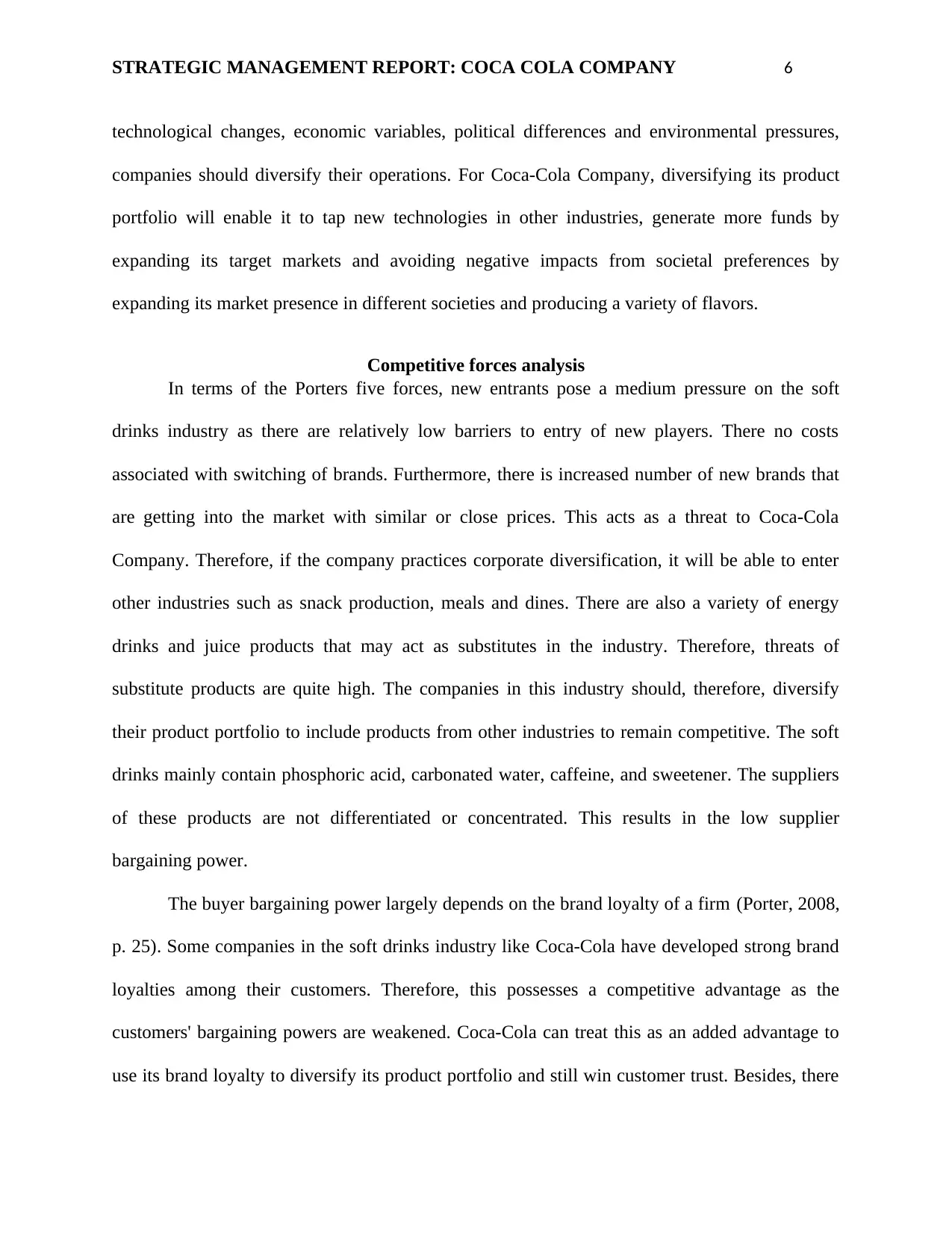
STRATEGIC MANAGEMENT REPORT: COCA COLA COMPANY 6
technological changes, economic variables, political differences and environmental pressures,
companies should diversify their operations. For Coca-Cola Company, diversifying its product
portfolio will enable it to tap new technologies in other industries, generate more funds by
expanding its target markets and avoiding negative impacts from societal preferences by
expanding its market presence in different societies and producing a variety of flavors.
Competitive forces analysis
In terms of the Porters five forces, new entrants pose a medium pressure on the soft
drinks industry as there are relatively low barriers to entry of new players. There no costs
associated with switching of brands. Furthermore, there is increased number of new brands that
are getting into the market with similar or close prices. This acts as a threat to Coca-Cola
Company. Therefore, if the company practices corporate diversification, it will be able to enter
other industries such as snack production, meals and dines. There are also a variety of energy
drinks and juice products that may act as substitutes in the industry. Therefore, threats of
substitute products are quite high. The companies in this industry should, therefore, diversify
their product portfolio to include products from other industries to remain competitive. The soft
drinks mainly contain phosphoric acid, carbonated water, caffeine, and sweetener. The suppliers
of these products are not differentiated or concentrated. This results in the low supplier
bargaining power.
The buyer bargaining power largely depends on the brand loyalty of a firm (Porter, 2008,
p. 25). Some companies in the soft drinks industry like Coca-Cola have developed strong brand
loyalties among their customers. Therefore, this possesses a competitive advantage as the
customers' bargaining powers are weakened. Coca-Cola can treat this as an added advantage to
use its brand loyalty to diversify its product portfolio and still win customer trust. Besides, there
technological changes, economic variables, political differences and environmental pressures,
companies should diversify their operations. For Coca-Cola Company, diversifying its product
portfolio will enable it to tap new technologies in other industries, generate more funds by
expanding its target markets and avoiding negative impacts from societal preferences by
expanding its market presence in different societies and producing a variety of flavors.
Competitive forces analysis
In terms of the Porters five forces, new entrants pose a medium pressure on the soft
drinks industry as there are relatively low barriers to entry of new players. There no costs
associated with switching of brands. Furthermore, there is increased number of new brands that
are getting into the market with similar or close prices. This acts as a threat to Coca-Cola
Company. Therefore, if the company practices corporate diversification, it will be able to enter
other industries such as snack production, meals and dines. There are also a variety of energy
drinks and juice products that may act as substitutes in the industry. Therefore, threats of
substitute products are quite high. The companies in this industry should, therefore, diversify
their product portfolio to include products from other industries to remain competitive. The soft
drinks mainly contain phosphoric acid, carbonated water, caffeine, and sweetener. The suppliers
of these products are not differentiated or concentrated. This results in the low supplier
bargaining power.
The buyer bargaining power largely depends on the brand loyalty of a firm (Porter, 2008,
p. 25). Some companies in the soft drinks industry like Coca-Cola have developed strong brand
loyalties among their customers. Therefore, this possesses a competitive advantage as the
customers' bargaining powers are weakened. Coca-Cola can treat this as an added advantage to
use its brand loyalty to diversify its product portfolio and still win customer trust. Besides, there
⊘ This is a preview!⊘
Do you want full access?
Subscribe today to unlock all pages.

Trusted by 1+ million students worldwide
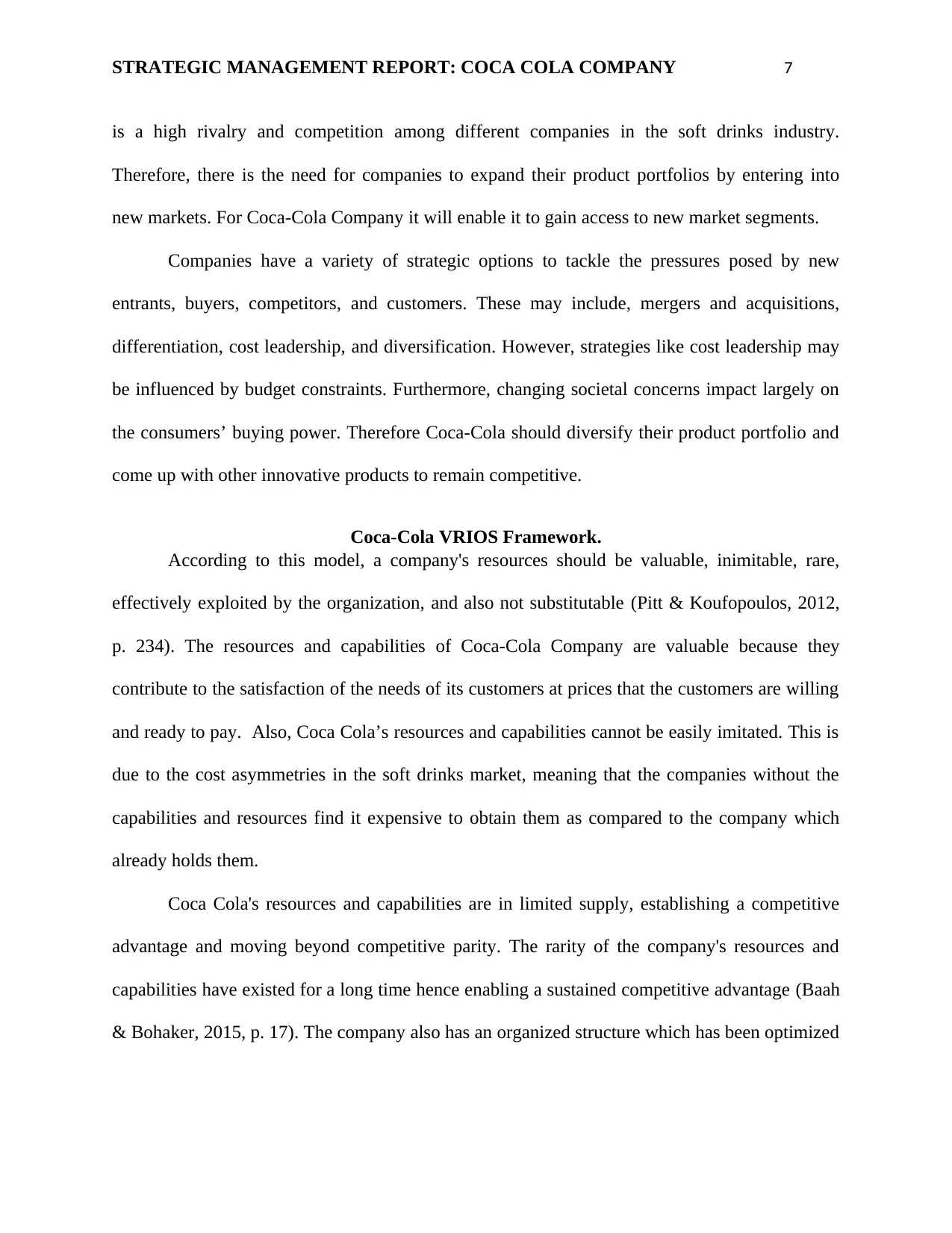
STRATEGIC MANAGEMENT REPORT: COCA COLA COMPANY 7
is a high rivalry and competition among different companies in the soft drinks industry.
Therefore, there is the need for companies to expand their product portfolios by entering into
new markets. For Coca-Cola Company it will enable it to gain access to new market segments.
Companies have a variety of strategic options to tackle the pressures posed by new
entrants, buyers, competitors, and customers. These may include, mergers and acquisitions,
differentiation, cost leadership, and diversification. However, strategies like cost leadership may
be influenced by budget constraints. Furthermore, changing societal concerns impact largely on
the consumers’ buying power. Therefore Coca-Cola should diversify their product portfolio and
come up with other innovative products to remain competitive.
Coca-Cola VRIOS Framework.
According to this model, a company's resources should be valuable, inimitable, rare,
effectively exploited by the organization, and also not substitutable (Pitt & Koufopoulos, 2012,
p. 234). The resources and capabilities of Coca-Cola Company are valuable because they
contribute to the satisfaction of the needs of its customers at prices that the customers are willing
and ready to pay. Also, Coca Cola’s resources and capabilities cannot be easily imitated. This is
due to the cost asymmetries in the soft drinks market, meaning that the companies without the
capabilities and resources find it expensive to obtain them as compared to the company which
already holds them.
Coca Cola's resources and capabilities are in limited supply, establishing a competitive
advantage and moving beyond competitive parity. The rarity of the company's resources and
capabilities have existed for a long time hence enabling a sustained competitive advantage (Baah
& Bohaker, 2015, p. 17). The company also has an organized structure which has been optimized
is a high rivalry and competition among different companies in the soft drinks industry.
Therefore, there is the need for companies to expand their product portfolios by entering into
new markets. For Coca-Cola Company it will enable it to gain access to new market segments.
Companies have a variety of strategic options to tackle the pressures posed by new
entrants, buyers, competitors, and customers. These may include, mergers and acquisitions,
differentiation, cost leadership, and diversification. However, strategies like cost leadership may
be influenced by budget constraints. Furthermore, changing societal concerns impact largely on
the consumers’ buying power. Therefore Coca-Cola should diversify their product portfolio and
come up with other innovative products to remain competitive.
Coca-Cola VRIOS Framework.
According to this model, a company's resources should be valuable, inimitable, rare,
effectively exploited by the organization, and also not substitutable (Pitt & Koufopoulos, 2012,
p. 234). The resources and capabilities of Coca-Cola Company are valuable because they
contribute to the satisfaction of the needs of its customers at prices that the customers are willing
and ready to pay. Also, Coca Cola’s resources and capabilities cannot be easily imitated. This is
due to the cost asymmetries in the soft drinks market, meaning that the companies without the
capabilities and resources find it expensive to obtain them as compared to the company which
already holds them.
Coca Cola's resources and capabilities are in limited supply, establishing a competitive
advantage and moving beyond competitive parity. The rarity of the company's resources and
capabilities have existed for a long time hence enabling a sustained competitive advantage (Baah
& Bohaker, 2015, p. 17). The company also has an organized structure which has been optimized
Paraphrase This Document
Need a fresh take? Get an instant paraphrase of this document with our AI Paraphraser
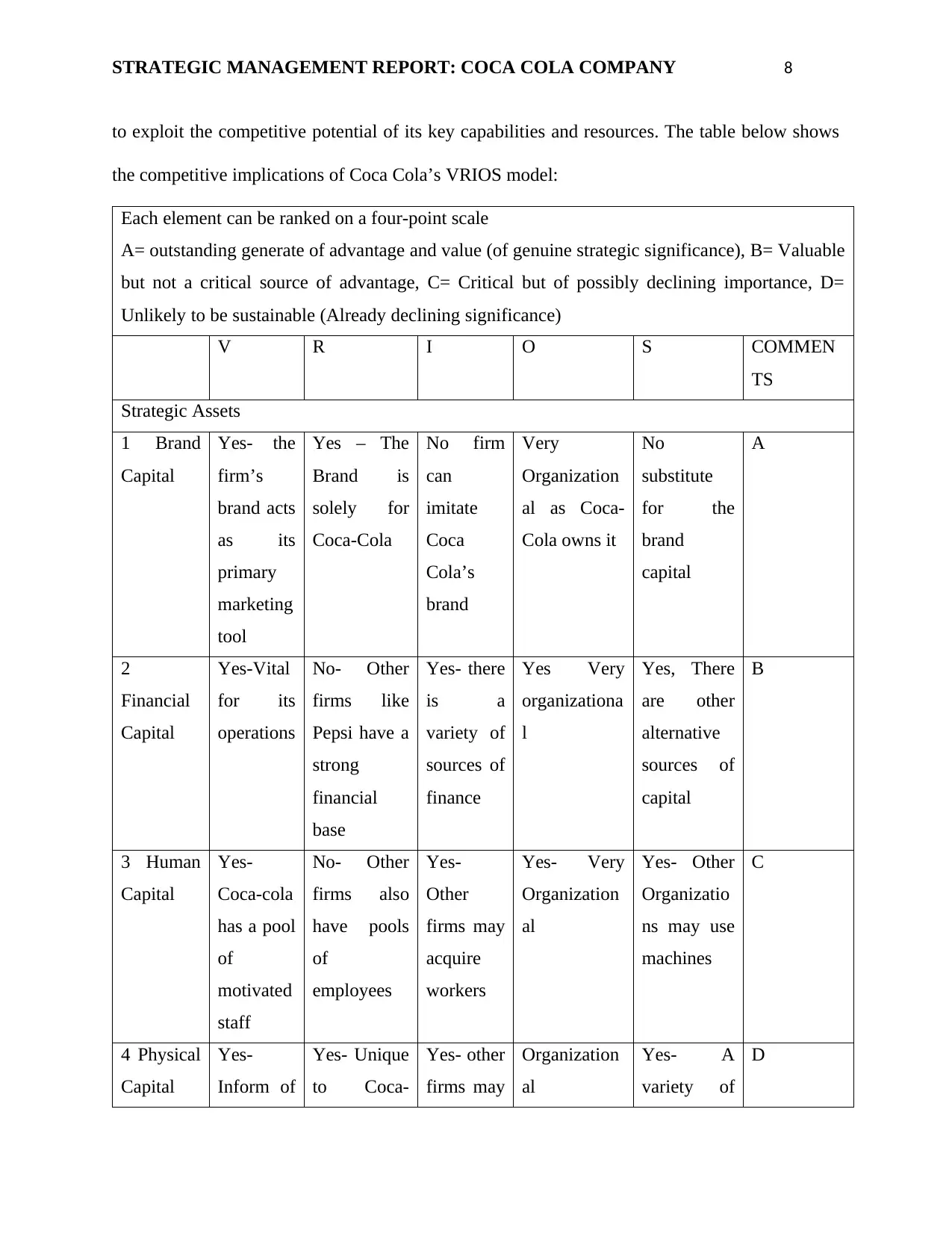
STRATEGIC MANAGEMENT REPORT: COCA COLA COMPANY 8
to exploit the competitive potential of its key capabilities and resources. The table below shows
the competitive implications of Coca Cola’s VRIOS model:
Each element can be ranked on a four-point scale
A= outstanding generate of advantage and value (of genuine strategic significance), B= Valuable
but not a critical source of advantage, C= Critical but of possibly declining importance, D=
Unlikely to be sustainable (Already declining significance)
V R I O S COMMEN
TS
Strategic Assets
1 Brand
Capital
Yes- the
firm’s
brand acts
as its
primary
marketing
tool
Yes – The
Brand is
solely for
Coca-Cola
No firm
can
imitate
Coca
Cola’s
brand
Very
Organization
al as Coca-
Cola owns it
No
substitute
for the
brand
capital
A
2
Financial
Capital
Yes-Vital
for its
operations
No- Other
firms like
Pepsi have a
strong
financial
base
Yes- there
is a
variety of
sources of
finance
Yes Very
organizationa
l
Yes, There
are other
alternative
sources of
capital
B
3 Human
Capital
Yes-
Coca-cola
has a pool
of
motivated
staff
No- Other
firms also
have pools
of
employees
Yes-
Other
firms may
acquire
workers
Yes- Very
Organization
al
Yes- Other
Organizatio
ns may use
machines
C
4 Physical
Capital
Yes-
Inform of
Yes- Unique
to Coca-
Yes- other
firms may
Organization
al
Yes- A
variety of
D
to exploit the competitive potential of its key capabilities and resources. The table below shows
the competitive implications of Coca Cola’s VRIOS model:
Each element can be ranked on a four-point scale
A= outstanding generate of advantage and value (of genuine strategic significance), B= Valuable
but not a critical source of advantage, C= Critical but of possibly declining importance, D=
Unlikely to be sustainable (Already declining significance)
V R I O S COMMEN
TS
Strategic Assets
1 Brand
Capital
Yes- the
firm’s
brand acts
as its
primary
marketing
tool
Yes – The
Brand is
solely for
Coca-Cola
No firm
can
imitate
Coca
Cola’s
brand
Very
Organization
al as Coca-
Cola owns it
No
substitute
for the
brand
capital
A
2
Financial
Capital
Yes-Vital
for its
operations
No- Other
firms like
Pepsi have a
strong
financial
base
Yes- there
is a
variety of
sources of
finance
Yes Very
organizationa
l
Yes, There
are other
alternative
sources of
capital
B
3 Human
Capital
Yes-
Coca-cola
has a pool
of
motivated
staff
No- Other
firms also
have pools
of
employees
Yes-
Other
firms may
acquire
workers
Yes- Very
Organization
al
Yes- Other
Organizatio
ns may use
machines
C
4 Physical
Capital
Yes-
Inform of
Yes- Unique
to Coca-
Yes- other
firms may
Organization
al
Yes- A
variety of
D
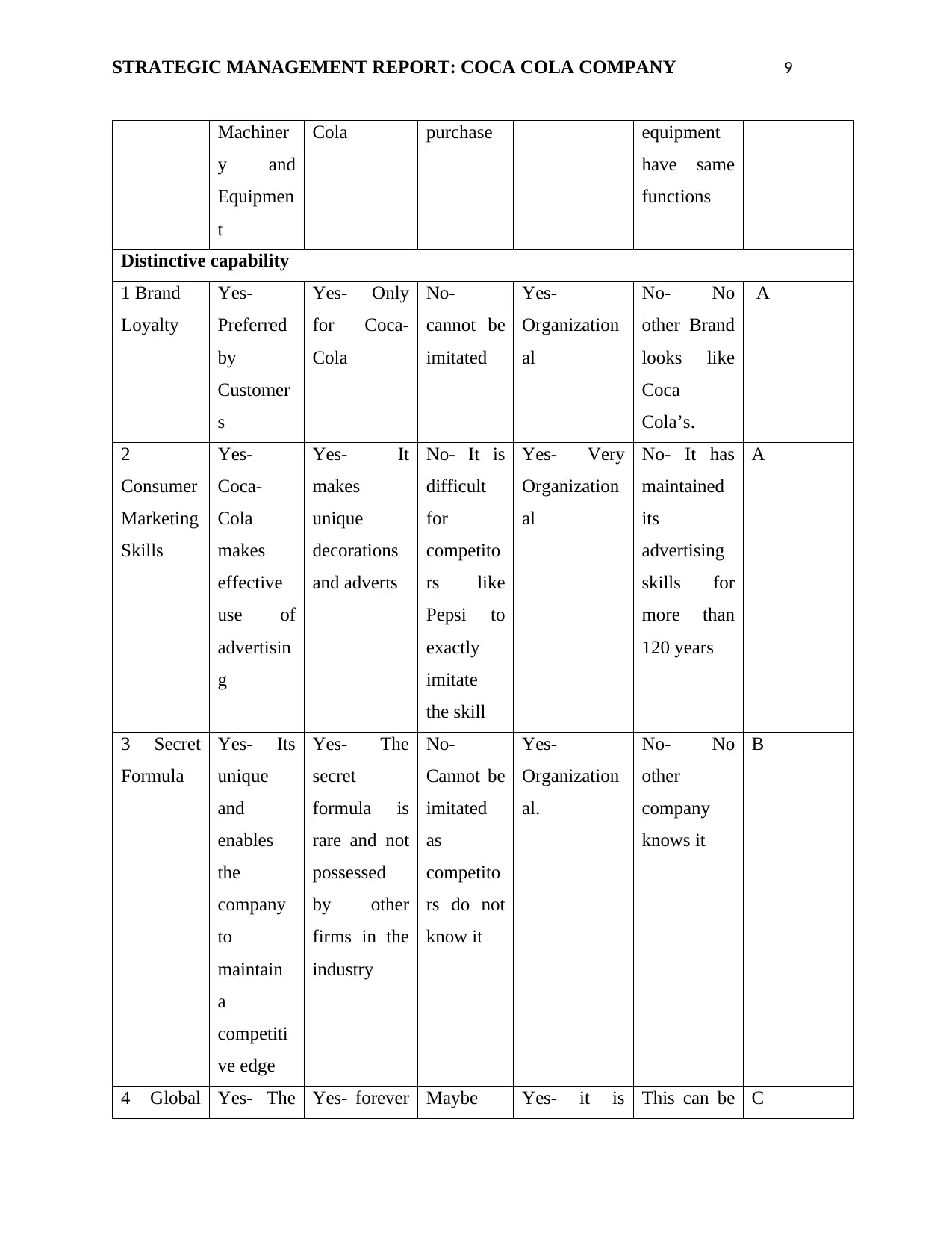
STRATEGIC MANAGEMENT REPORT: COCA COLA COMPANY 9
Machiner
y and
Equipmen
t
Cola purchase equipment
have same
functions
Distinctive capability
1 Brand
Loyalty
Yes-
Preferred
by
Customer
s
Yes- Only
for Coca-
Cola
No-
cannot be
imitated
Yes-
Organization
al
No- No
other Brand
looks like
Coca
Cola’s.
A
2
Consumer
Marketing
Skills
Yes-
Coca-
Cola
makes
effective
use of
advertisin
g
Yes- It
makes
unique
decorations
and adverts
No- It is
difficult
for
competito
rs like
Pepsi to
exactly
imitate
the skill
Yes- Very
Organization
al
No- It has
maintained
its
advertising
skills for
more than
120 years
A
3 Secret
Formula
Yes- Its
unique
and
enables
the
company
to
maintain
a
competiti
ve edge
Yes- The
secret
formula is
rare and not
possessed
by other
firms in the
industry
No-
Cannot be
imitated
as
competito
rs do not
know it
Yes-
Organization
al.
No- No
other
company
knows it
B
4 Global Yes- The Yes- forever Maybe Yes- it is This can be C
Machiner
y and
Equipmen
t
Cola purchase equipment
have same
functions
Distinctive capability
1 Brand
Loyalty
Yes-
Preferred
by
Customer
s
Yes- Only
for Coca-
Cola
No-
cannot be
imitated
Yes-
Organization
al
No- No
other Brand
looks like
Coca
Cola’s.
A
2
Consumer
Marketing
Skills
Yes-
Coca-
Cola
makes
effective
use of
advertisin
g
Yes- It
makes
unique
decorations
and adverts
No- It is
difficult
for
competito
rs like
Pepsi to
exactly
imitate
the skill
Yes- Very
Organization
al
No- It has
maintained
its
advertising
skills for
more than
120 years
A
3 Secret
Formula
Yes- Its
unique
and
enables
the
company
to
maintain
a
competiti
ve edge
Yes- The
secret
formula is
rare and not
possessed
by other
firms in the
industry
No-
Cannot be
imitated
as
competito
rs do not
know it
Yes-
Organization
al.
No- No
other
company
knows it
B
4 Global Yes- The Yes- forever Maybe Yes- it is This can be C
⊘ This is a preview!⊘
Do you want full access?
Subscribe today to unlock all pages.

Trusted by 1+ million students worldwide
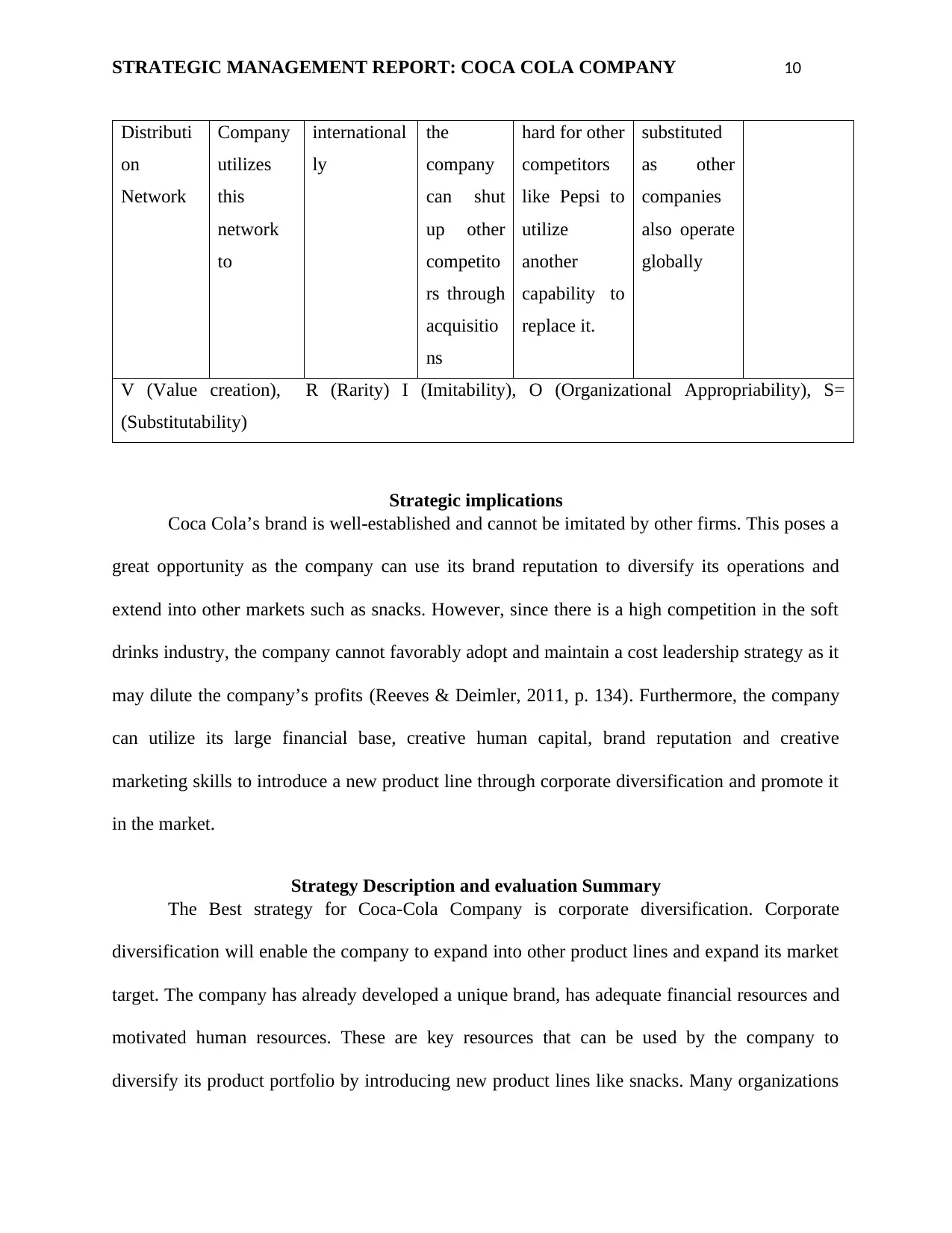
STRATEGIC MANAGEMENT REPORT: COCA COLA COMPANY 10
Distributi
on
Network
Company
utilizes
this
network
to
international
ly
the
company
can shut
up other
competito
rs through
acquisitio
ns
hard for other
competitors
like Pepsi to
utilize
another
capability to
replace it.
substituted
as other
companies
also operate
globally
V (Value creation), R (Rarity) I (Imitability), O (Organizational Appropriability), S=
(Substitutability)
Strategic implications
Coca Cola’s brand is well-established and cannot be imitated by other firms. This poses a
great opportunity as the company can use its brand reputation to diversify its operations and
extend into other markets such as snacks. However, since there is a high competition in the soft
drinks industry, the company cannot favorably adopt and maintain a cost leadership strategy as it
may dilute the company’s profits (Reeves & Deimler, 2011, p. 134). Furthermore, the company
can utilize its large financial base, creative human capital, brand reputation and creative
marketing skills to introduce a new product line through corporate diversification and promote it
in the market.
Strategy Description and evaluation Summary
The Best strategy for Coca-Cola Company is corporate diversification. Corporate
diversification will enable the company to expand into other product lines and expand its market
target. The company has already developed a unique brand, has adequate financial resources and
motivated human resources. These are key resources that can be used by the company to
diversify its product portfolio by introducing new product lines like snacks. Many organizations
Distributi
on
Network
Company
utilizes
this
network
to
international
ly
the
company
can shut
up other
competito
rs through
acquisitio
ns
hard for other
competitors
like Pepsi to
utilize
another
capability to
replace it.
substituted
as other
companies
also operate
globally
V (Value creation), R (Rarity) I (Imitability), O (Organizational Appropriability), S=
(Substitutability)
Strategic implications
Coca Cola’s brand is well-established and cannot be imitated by other firms. This poses a
great opportunity as the company can use its brand reputation to diversify its operations and
extend into other markets such as snacks. However, since there is a high competition in the soft
drinks industry, the company cannot favorably adopt and maintain a cost leadership strategy as it
may dilute the company’s profits (Reeves & Deimler, 2011, p. 134). Furthermore, the company
can utilize its large financial base, creative human capital, brand reputation and creative
marketing skills to introduce a new product line through corporate diversification and promote it
in the market.
Strategy Description and evaluation Summary
The Best strategy for Coca-Cola Company is corporate diversification. Corporate
diversification will enable the company to expand into other product lines and expand its market
target. The company has already developed a unique brand, has adequate financial resources and
motivated human resources. These are key resources that can be used by the company to
diversify its product portfolio by introducing new product lines like snacks. Many organizations
Paraphrase This Document
Need a fresh take? Get an instant paraphrase of this document with our AI Paraphraser
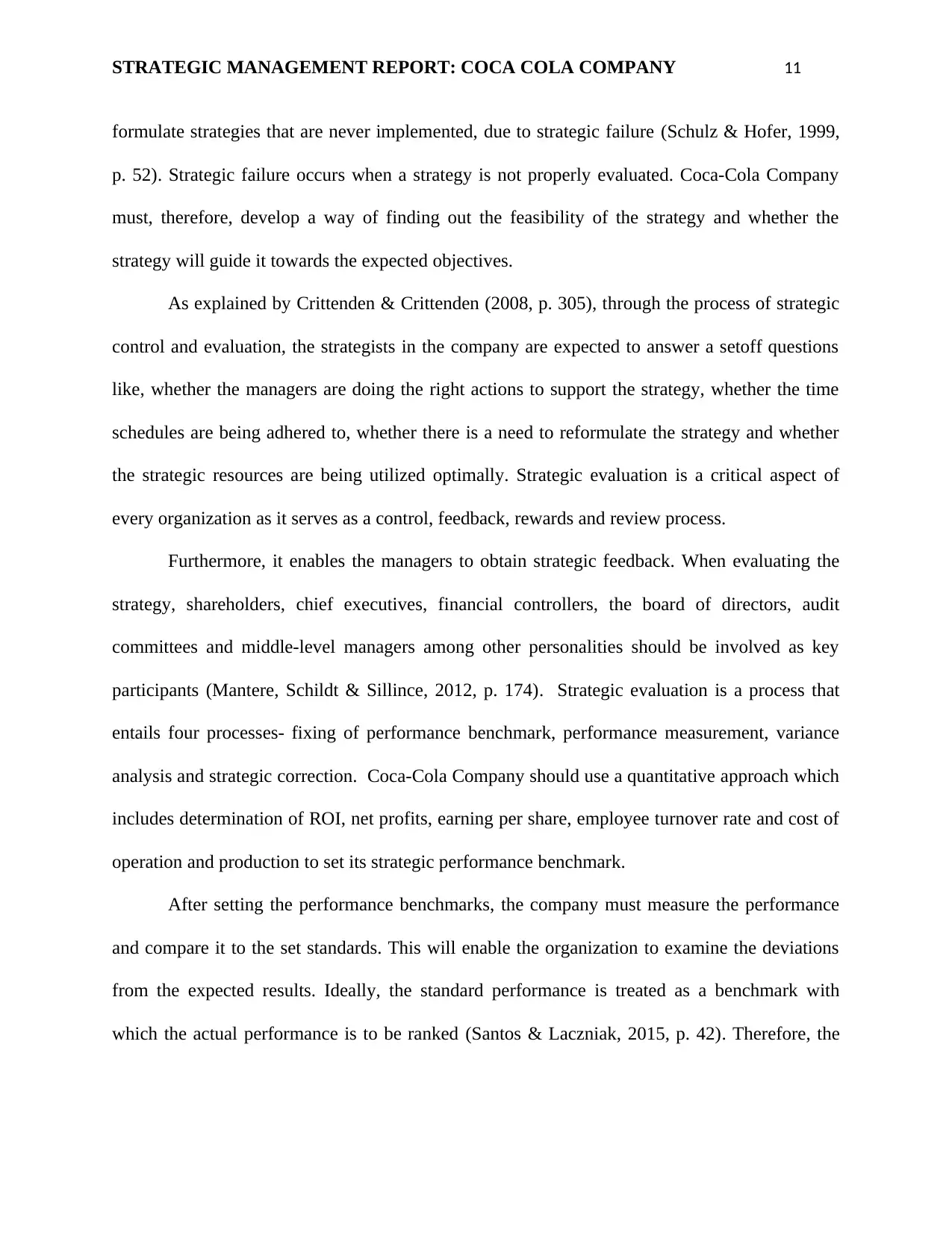
STRATEGIC MANAGEMENT REPORT: COCA COLA COMPANY 11
formulate strategies that are never implemented, due to strategic failure (Schulz & Hofer, 1999,
p. 52). Strategic failure occurs when a strategy is not properly evaluated. Coca-Cola Company
must, therefore, develop a way of finding out the feasibility of the strategy and whether the
strategy will guide it towards the expected objectives.
As explained by Crittenden & Crittenden (2008, p. 305), through the process of strategic
control and evaluation, the strategists in the company are expected to answer a setoff questions
like, whether the managers are doing the right actions to support the strategy, whether the time
schedules are being adhered to, whether there is a need to reformulate the strategy and whether
the strategic resources are being utilized optimally. Strategic evaluation is a critical aspect of
every organization as it serves as a control, feedback, rewards and review process.
Furthermore, it enables the managers to obtain strategic feedback. When evaluating the
strategy, shareholders, chief executives, financial controllers, the board of directors, audit
committees and middle-level managers among other personalities should be involved as key
participants (Mantere, Schildt & Sillince, 2012, p. 174). Strategic evaluation is a process that
entails four processes- fixing of performance benchmark, performance measurement, variance
analysis and strategic correction. Coca-Cola Company should use a quantitative approach which
includes determination of ROI, net profits, earning per share, employee turnover rate and cost of
operation and production to set its strategic performance benchmark.
After setting the performance benchmarks, the company must measure the performance
and compare it to the set standards. This will enable the organization to examine the deviations
from the expected results. Ideally, the standard performance is treated as a benchmark with
which the actual performance is to be ranked (Santos & Laczniak, 2015, p. 42). Therefore, the
formulate strategies that are never implemented, due to strategic failure (Schulz & Hofer, 1999,
p. 52). Strategic failure occurs when a strategy is not properly evaluated. Coca-Cola Company
must, therefore, develop a way of finding out the feasibility of the strategy and whether the
strategy will guide it towards the expected objectives.
As explained by Crittenden & Crittenden (2008, p. 305), through the process of strategic
control and evaluation, the strategists in the company are expected to answer a setoff questions
like, whether the managers are doing the right actions to support the strategy, whether the time
schedules are being adhered to, whether there is a need to reformulate the strategy and whether
the strategic resources are being utilized optimally. Strategic evaluation is a critical aspect of
every organization as it serves as a control, feedback, rewards and review process.
Furthermore, it enables the managers to obtain strategic feedback. When evaluating the
strategy, shareholders, chief executives, financial controllers, the board of directors, audit
committees and middle-level managers among other personalities should be involved as key
participants (Mantere, Schildt & Sillince, 2012, p. 174). Strategic evaluation is a process that
entails four processes- fixing of performance benchmark, performance measurement, variance
analysis and strategic correction. Coca-Cola Company should use a quantitative approach which
includes determination of ROI, net profits, earning per share, employee turnover rate and cost of
operation and production to set its strategic performance benchmark.
After setting the performance benchmarks, the company must measure the performance
and compare it to the set standards. This will enable the organization to examine the deviations
from the expected results. Ideally, the standard performance is treated as a benchmark with
which the actual performance is to be ranked (Santos & Laczniak, 2015, p. 42). Therefore, the
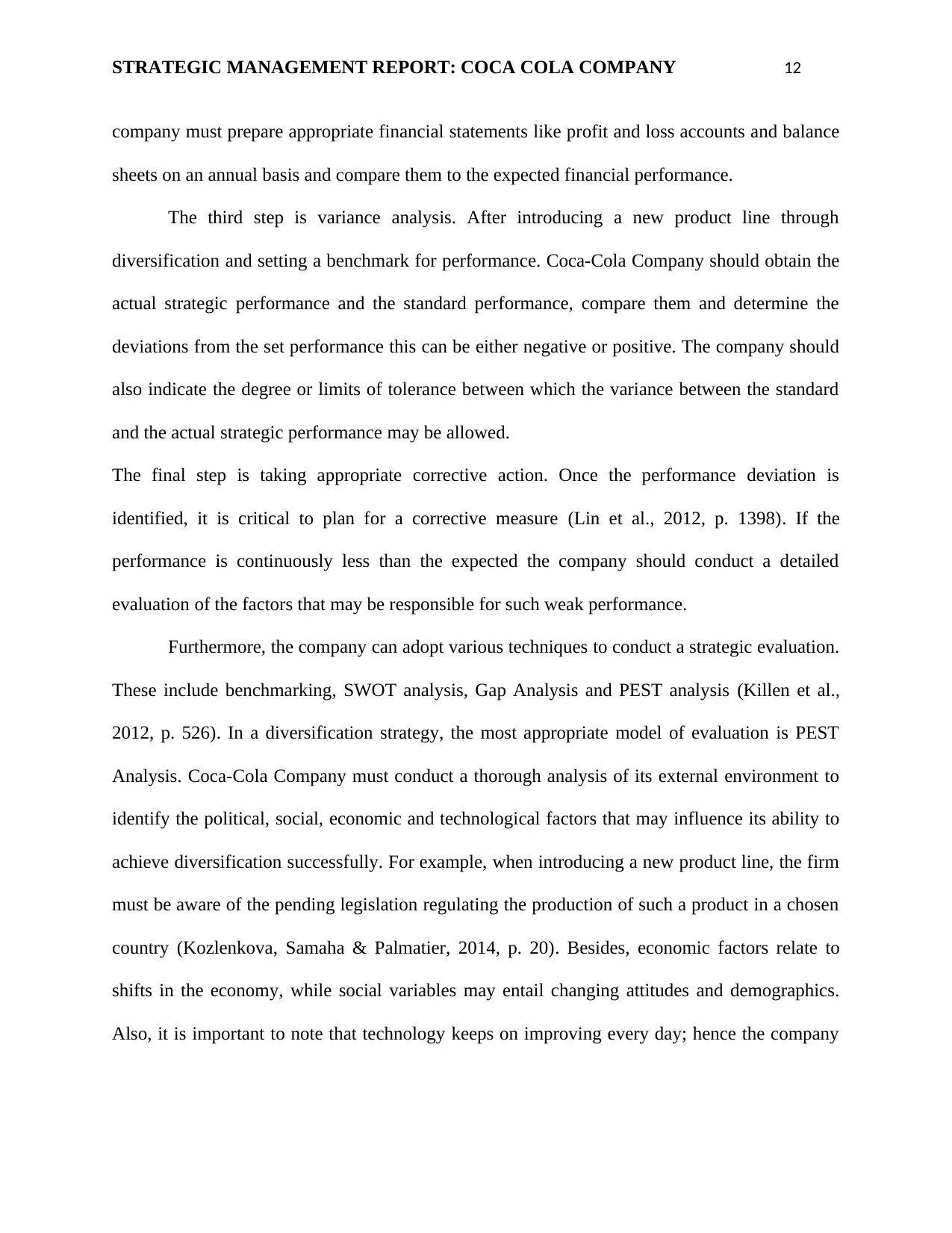
STRATEGIC MANAGEMENT REPORT: COCA COLA COMPANY 12
company must prepare appropriate financial statements like profit and loss accounts and balance
sheets on an annual basis and compare them to the expected financial performance.
The third step is variance analysis. After introducing a new product line through
diversification and setting a benchmark for performance. Coca-Cola Company should obtain the
actual strategic performance and the standard performance, compare them and determine the
deviations from the set performance this can be either negative or positive. The company should
also indicate the degree or limits of tolerance between which the variance between the standard
and the actual strategic performance may be allowed.
The final step is taking appropriate corrective action. Once the performance deviation is
identified, it is critical to plan for a corrective measure (Lin et al., 2012, p. 1398). If the
performance is continuously less than the expected the company should conduct a detailed
evaluation of the factors that may be responsible for such weak performance.
Furthermore, the company can adopt various techniques to conduct a strategic evaluation.
These include benchmarking, SWOT analysis, Gap Analysis and PEST analysis (Killen et al.,
2012, p. 526). In a diversification strategy, the most appropriate model of evaluation is PEST
Analysis. Coca-Cola Company must conduct a thorough analysis of its external environment to
identify the political, social, economic and technological factors that may influence its ability to
achieve diversification successfully. For example, when introducing a new product line, the firm
must be aware of the pending legislation regulating the production of such a product in a chosen
country (Kozlenkova, Samaha & Palmatier, 2014, p. 20). Besides, economic factors relate to
shifts in the economy, while social variables may entail changing attitudes and demographics.
Also, it is important to note that technology keeps on improving every day; hence the company
company must prepare appropriate financial statements like profit and loss accounts and balance
sheets on an annual basis and compare them to the expected financial performance.
The third step is variance analysis. After introducing a new product line through
diversification and setting a benchmark for performance. Coca-Cola Company should obtain the
actual strategic performance and the standard performance, compare them and determine the
deviations from the set performance this can be either negative or positive. The company should
also indicate the degree or limits of tolerance between which the variance between the standard
and the actual strategic performance may be allowed.
The final step is taking appropriate corrective action. Once the performance deviation is
identified, it is critical to plan for a corrective measure (Lin et al., 2012, p. 1398). If the
performance is continuously less than the expected the company should conduct a detailed
evaluation of the factors that may be responsible for such weak performance.
Furthermore, the company can adopt various techniques to conduct a strategic evaluation.
These include benchmarking, SWOT analysis, Gap Analysis and PEST analysis (Killen et al.,
2012, p. 526). In a diversification strategy, the most appropriate model of evaluation is PEST
Analysis. Coca-Cola Company must conduct a thorough analysis of its external environment to
identify the political, social, economic and technological factors that may influence its ability to
achieve diversification successfully. For example, when introducing a new product line, the firm
must be aware of the pending legislation regulating the production of such a product in a chosen
country (Kozlenkova, Samaha & Palmatier, 2014, p. 20). Besides, economic factors relate to
shifts in the economy, while social variables may entail changing attitudes and demographics.
Also, it is important to note that technology keeps on improving every day; hence the company
⊘ This is a preview!⊘
Do you want full access?
Subscribe today to unlock all pages.

Trusted by 1+ million students worldwide
1 out of 19
Related Documents
Your All-in-One AI-Powered Toolkit for Academic Success.
+13062052269
info@desklib.com
Available 24*7 on WhatsApp / Email
![[object Object]](/_next/static/media/star-bottom.7253800d.svg)
Unlock your academic potential
Copyright © 2020–2025 A2Z Services. All Rights Reserved. Developed and managed by ZUCOL.





